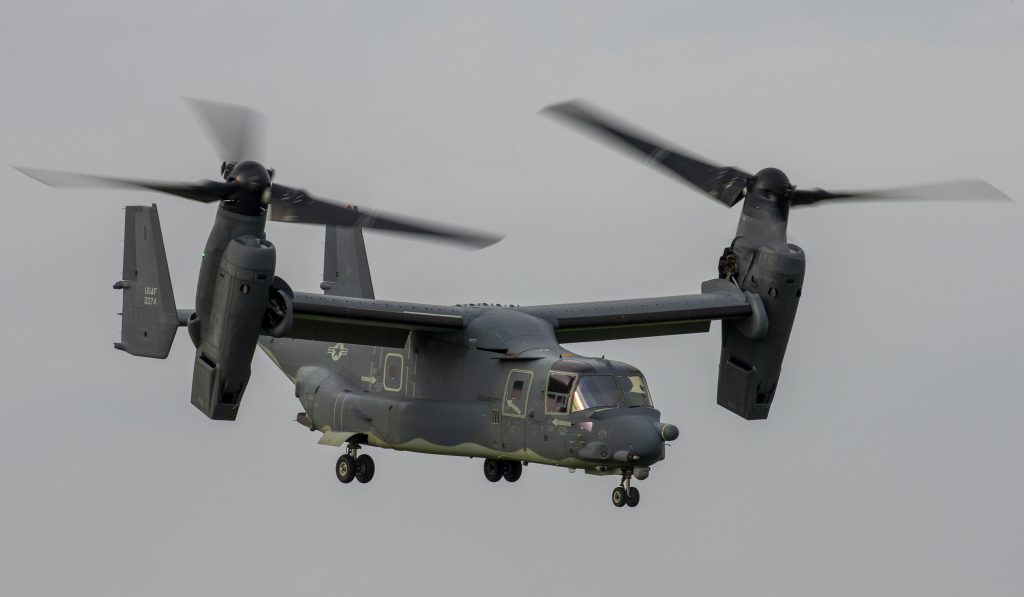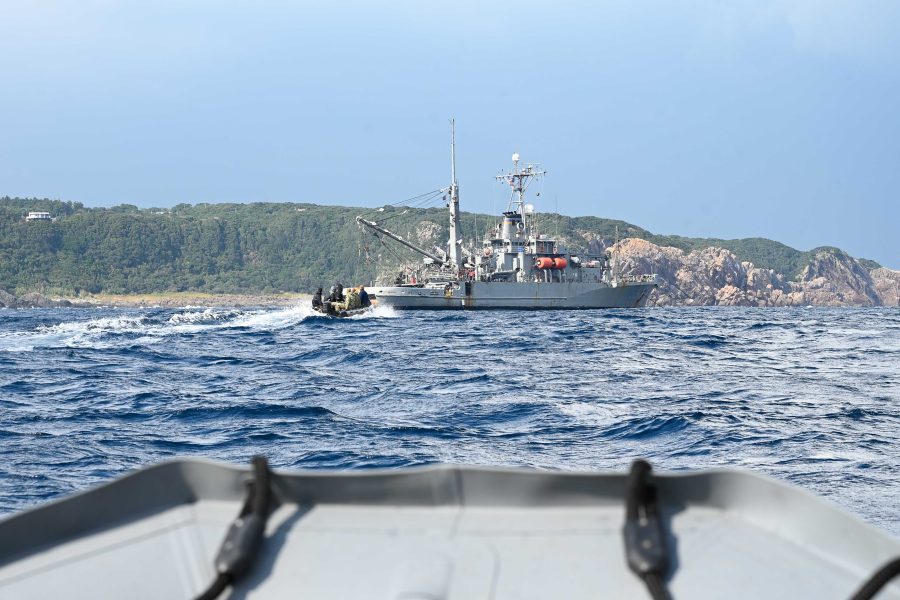Forty-three days after a U.S. Air Force CV-22 Osprey crashed off the coast of Japan, the Pentagon has halted search and recovery operations, Air Force Special Operations Command announced Jan. 11. Of the eight Airmen killed in the crash, the remains of one, Maj. Eric Spendlove, were not recovered.
The U.S. military, Japan Coast Guard, Japan Self-Defense Forces, local law enforcement, and civilian volunteers participated in search and rescue efforts starting Nov. 29, 2023, that eventually transitioned to search and recovery operations. In a release, AFSOC said the effort included:
- More than 1,000 personnel
- 46 aircraft
- 23 maritime vessels
- 21 unmanned aerial and underwater systems
The search covered 60,000 square kilometers of the ocean’s surface and 39 square kilometers of the ocean floor. The bodies of seven Airmen and the bulk of the CV-22 wreckage were recovered.
Spendlove, 36, of St. George, Utah, was a residency-trained flight surgeon and medical operations flight commander assigned to the 1st Special Operations Squadron at Kadena Air Base, Japan.
“While it is with tremendous deep regret that we were unable to find our last teammate, Maj. Eric Spendlove, the combined joint efforts of our Japanese allies and U.S. military forces has been inspiring to see the lengths our forces will go in order to attempt to bring a teammate home,” Rear Adm. Jeromy Williams, commander of Special Operations Command Pacific, said in a statement. “Our main priority since the mishap has been locating and bringing our Heroes back to their families. After over a month of exhausting air, surface, sub-surface, and modeling and simulation assets, we have ruled out all identified possible options to recover our teammate. Our thoughts remain with the families and squadron mates of our CV-22 aircrew and we extend our sincerest gratitude to every asset who assisted in the search.”

The other seven Airmen killed in the crash were:
- Maj. Jeffrey T. Hoernemann, 32, of Andover, Minn., a CV-22 instructor pilot and officer in charge of training assigned to the 21st Special Operations Squadron, 353rd Special Operations Wing, Yokota Air Base, Japan.
- Maj. Luke A. Unrath, 34, of Riverside, Calif., was a CV-22 pilot and flight commander assigned to the 21st Special Operations Squadron, 353rd Special Operations Wing, Yokota Air Base, Japan.
- Capt. Terrell K. Brayman, 32, of Pittsford, N.Y., was a CV-22 pilot and flight commander assigned to the 21st Special Operations Squadron, 353rd Special Operations Wing, Yokota Air Base, Japan.
- Tech. Sgt. Zachary E. Lavoy, 33, of Oviedo, Fla., was a medical operations flight chief assigned to the 1st Special Operations Squadron, 353rd Special Operations Wing, Kadena Air Base, Japan.
- Staff Sgt. Jacob “Jake” M. Galliher, 24, of Pittsfield, Mass., who was a Direct Support Operator and airborne linguist specializing in Mandarin with the 43rd Intelligence Squadron, Detachment 1, Operating Location—Alpha.
- Staff Sgt. Jake M. Turnage, 25, of Kennesaw, Ga., was a flight engineer assigned to the 21st Special Operations Squadron, 353rd Special Operations Wing, Yokota Air Base, Japan.
- Senior Airman Brian K. Johnson, 32, of Reynoldsburg, Ohio, was a flight engineer assigned to the 21st Special Operations Squadron, 353rd Special Operations Wing, Yokota Air Base, Japan.
The cause of the crash, the deadliest Air Force aviation mishap since 2018, has not been identified, but AFSOC has previously stated initial findings suggested there was a “material failure” with the Osprey, indicating pilot error was likely not the primary cause and there was an issue with the aircraft itself.
The Air Force, Navy, and Marine Corps have all implemented standdowns for their V-22 fleets while the crash is investigated. AFSOC announced Jan. 3 that it had recovered the “black box,” the voice and data recorder, from the aircraft—likely a key piece in the investigation.
While an Air Force Accident Investigation Board will probe the specific causes of the Nov. 29 mishap, there will be multiple other investigations into the V-22 more broadly, which has garnered a reputation for safety incidents. In August 2023, three Marines were killed when their Osprey crashed in Australia. In 2022, two separate crashes in San Diego and Norway resulted in the deaths of nine Marines.
Air & Space Forces Magazine has confirmed the Government Accountability Office will initiate a review of “matters relating to accidents involving Osprey tilt-rotor aircraft (V-22) during military training exercises and operations,” at the request of Reps. Michael Waltz (R-Fla.) and John Garamendi (D-Calif.), the top lawmakers on the House Armed Services readiness subcommittee.
Separately, the House Oversight Committee has requested documents from the Pentagon related to the Osprey’s safety as part of its own investigation.
“The Department of Defense commits to working cooperatively with the committee to accommodate its requests,” Pentagon Press Secretary Air Force Maj. Gen. Patrick S. Ryder said Jan. 4. “We’ll work diligently to provide additional information as soon as possible.”
